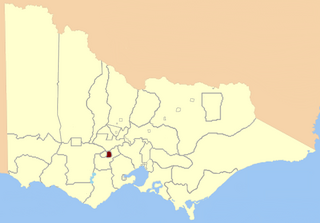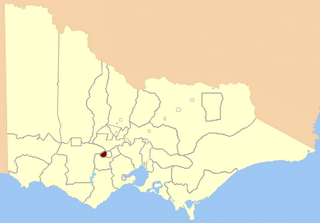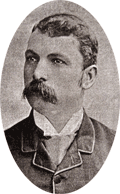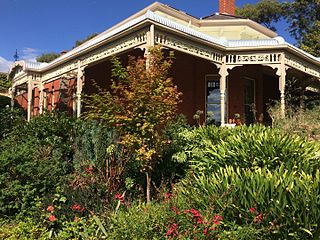
The Division of Ballarat is an Australian electoral division in the state of Victoria. The division was proclaimed in 1900, and was one of the original 65 divisions to be contested at the first federal election. It was named for the provincial city of the same name by Scottish squatter Archibald Yuille, who established the first settlement − his sheep run called Ballaarat − in 1837, with the name derived from a local Wathawurrung word for the area, balla arat, thought to mean "resting place".
John Basson Humffray was a leading advocate in the movement of miner reform process in the British colony of Victoria, and later a member of parliament.

Ballarat East was an electoral district of the Legislative Assembly in the Australian state of Victoria. Prior to its abolition, it was a 3,323 km² part-urban and part-rural electorate covering areas to the east of the regional centre of Ballarat. It included the Ballarat suburbs of Ballarat East, Bakery Hill, Golden Point, Eureka, Canadian, Mount Pleasant, Mount Clear, Mount Helen and Warrenheip, and the rural towns of Ballan, Buninyong, Bungaree, Creswick, Daylesford, Dunnstown, Hepburn Springs, Kyneton, Lal Lal, Malmsbury, Meredith and Steiglitz. The electorate had a population of 54,127 as of the 2006 census, with 40,578 enrolled electors at the 2010 state election.

The Electoral district of Ballarat West was an electoral district of the Victorian Legislative Assembly in Australia. It existed from 1859–1927 and from 1992–2014.
James Scobie was a Scottish gold digger murdered at Ballarat, Victoria, Australia. His death was associated with a sequence of events which led to the Eureka Rebellion.

Michael Paul Nunan, CFC was a member of the Congregation of Christian Brothers and an influential educationalist in New Zealand, Victoria and, especially, Western Australia.

The City of Ballaarat was a local government area covering the inner suburbs of the regional city of Ballarat, Victoria, Australia. The city covered an area of 34.52 square kilometres (13.3 sq mi), and existed from 1855 until 1994.

The Shire of Ballarat was a local government area immediately to the northwest and west of the regional city of Ballarat, Victoria, Australia. The shire covered an area of 481.74 square kilometres (186.0 sq mi), and existed from 1856 until 1994.
This is a list of electoral results for the Division of Ballarat in Australian federal elections from the division's creation in 1901 until the present. The seat was known as Ballaarat from 1901 until 1977.

Henry Sutton was an Australian designer, engineer, and inventor credited with contributions to early developments in electricity, aviation, wireless communication, photography and telephony.

Ballarat Central is the central locality of Greater Ballarat in Victoria, Australia. The population of Ballarat Central at the 2021 census was 5,378, making it the sixth most populous in the urban area. It is the administrative headquarters for the City of Ballarat as well as the Ballarat Base Hospital and health services and home to the city's major religious institutions and a major retail, commercial and inner city residential area.
William James McAdam was an Australian politician.
The Electoral district of Ballarat was an electoral district of the old unicameral Victorian Legislative Council of 1851 to 1856. Victoria being a colony in Australia at the time. Ballaarat was added to the Council in 1855, along with four other districts.
Ballaarat Old Cemetery is a cemetery located in the rural city of Ballarat, Victoria in Australia. The cemetery dates back to 1856, although records show burials took place in the area from the late 1840s.

The Ballaarat Tramline, also known as the Lockville - Yoganup Railway, was the first railway in Western Australia, constructed in 1871 by the Western Australian Timber Company. The railway was used to transport timber from forests in the South West to the company's jetty at Lockville using the Ballaarat steam engine.

Frederick William Commons was an Australian monumental sculptor who was commissioned to carve the monuments in the Ballarat Town Hall. He was commissioned to carve four allegorical figures for Parliament House, Melbourne, each 12 ft high and for £2,100. However, it never eventuated due to the depression. Today, many of his works can be seen in statues and monuments in the Ballarat district.

Trelawny is a gracious heritage house located at 804 Havelock Street, Black Hill, a suburb of the Victorian gold rush city of Ballarat, Victoria, Australia. Havelock Street, the street where Trelawny is located, was named in recognition of Major General Sir Henry Havelock, a British general who is particularly associated with India and the Indian Mutiny of 1857.

The Ballaarat steam engine was built in Ballarat, Victoria in 1871 and was the first 3 ft 6 in gauge locomotive built in Australia. It was purchased by Western Australian Timber Company, which was awarded one of only three WA milling concessions granted. The company had 181,500 acres to mill at Yoganup near Busselton.
Alfred Ronalds was an English author, artisan and Australian pioneer, best known for his book The Fly-fisher's Entomology.










